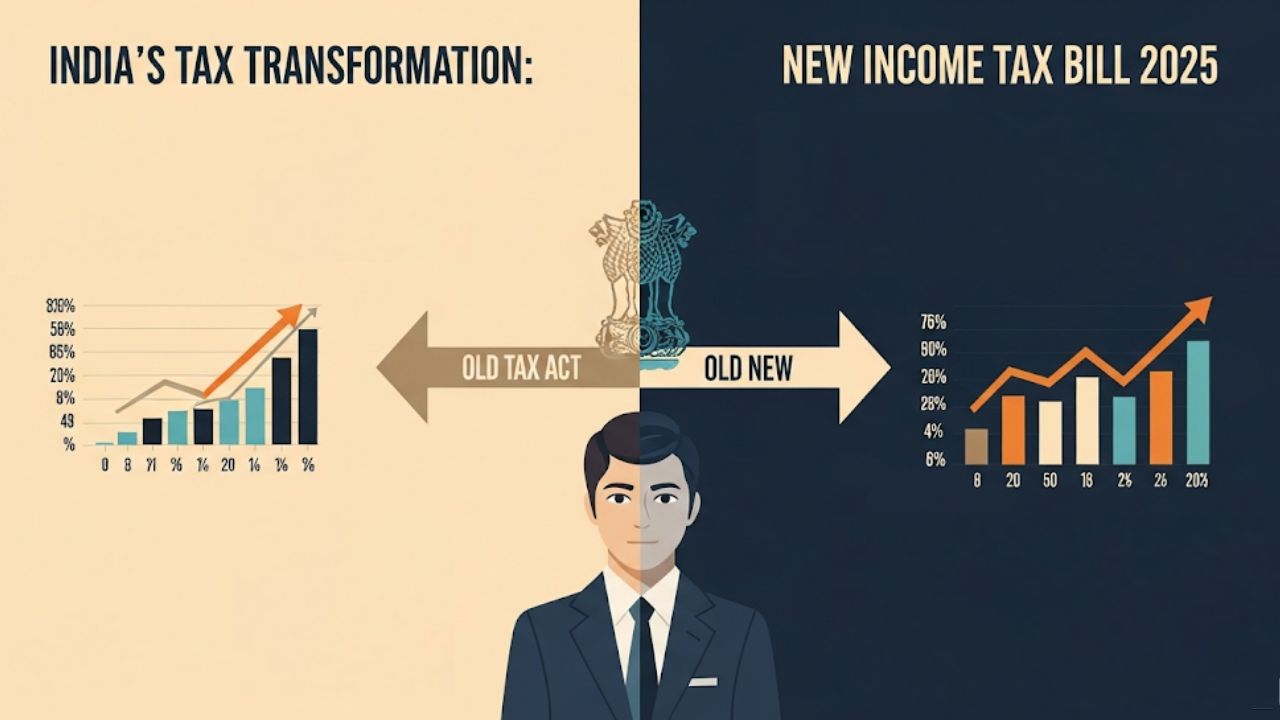India’s tax system is getting a major update with the Income Tax Bill 2025, set to replace the Income Tax Act of 1961. This new bill, passed by the Lok Sabha on August 11, 2025, aims to make taxes simpler, fairer, and more transparent for everyone. Let’s break down the key changes in simple words and compare them with the old tax rules to understand what’s new and how it impacts you.
What is the New Income Tax Bill 2025?
The Income Tax Bill 2025 is a modernized version of the old Income Tax Act, 1961, which had become complex due to many changes over the years. The new bill has fewer sections (536 vs. 819), simpler language, and a focus on digital processes. It will take effect from April 1, 2026, giving taxpayers time to adjust. The goal is to reduce confusion, lower disputes, and make tax filing easier.
Key Changes in the Income Tax Bill 2025
Here are the major updates in the new bill that every taxpayer should know:
- Single “Tax Year” System
The old system used “Previous Year” (when you earn income) and “Assessment Year” (when you pay tax). This was confusing. The new bill introduces a single Tax Year (April 1 to March 31), making tax filing and planning simpler. - No Tax Up to ₹12 Lakh
Under the new tax regime, if your income is up to ₹12 lakh per year, you pay zero tax. With a ₹75,000 standard deduction, this extends to ₹12.75 lakh. This is a big relief for middle-class taxpayers. - Refunds for Late Filings
Earlier, if you missed the tax filing deadline, you couldn’t claim a refund. The new bill allows refunds even if you file your return late, helping those who face delays due to illness or technical issues. - Tax Relief for Vacant Properties
If you own a property that’s empty, you can now claim tax relief. The old rules didn’t allow this, so property owners benefit from this change. - Clear Rules for House Property Deduction
The new bill clearly defines a 30% deduction on income from house property, making it easier for homeowners and investors to understand and claim. - NIL-TDS Certificates
If your income is below the taxable limit, you can apply for a NIL-TDS certificate in advance. This saves you from tax deductions on your income, especially helpful for low earners and NRIs. - Reintroduced Section 80M
The bill brings back the Section 80M deduction for inter-corporate dividends, preventing companies from being taxed twice on the same income. - Simplified Tax Structure
The bill cuts down the number of sections and removes complex legal terms like provisos and explanations. It uses tables and clear language to make tax rules easier to understand. - Digital and Faceless Assessments
Tax processes are going digital with faceless assessments, reducing direct contact with tax officers. This lowers corruption risks and speeds up processes. - Pension Benefits Expanded
The bill aligns the Unified Pension Scheme (UPS) with the National Pension System (NPS), offering tax exemptions on lump-sum withdrawals for both employees and non-employees.
Comparison: Old Income Tax Act 1961 vs. New Income Tax Bill 2025
Here’s a simple table comparing the old and new tax systems:
| Feature | Old Income Tax Act (1961) | New Income Tax Bill (2025) |
|---|---|---|
| Tax Year System | Previous Year + Assessment Year (complex) | Single Tax Year (April 1–March 31) |
| Number of Sections | 819 sections, 823 pages | 536 sections, 622 pages |
| Refunds for Late Filing | No refunds if filed late | Refunds allowed even for late filings |
| House Property Deduction | No clear definition for 30% deduction | Clear 30% deduction defined |
| Vacant Property Relief | No tax relief for vacant properties | Tax relief available for vacant properties |
| NIL-TDS Certificates | Not available | Available for low or no-tax payers |
| Section 80M (Dividends) | Not in effect | Reintroduced to avoid double taxation |
| TDS Provisions | Scattered across multiple sections | Consolidated under one section (393) |
| Digital Assessments | Limited digital processes | Faceless and digital-first assessments |
| Tax Slabs | Up to ₹3 lakh: Nil, then 5–30% | Up to ₹4 lakh: Nil, then 5–30% (no tax up to ₹12 lakh) |
How Does the New Bill Benefit Taxpayers?
- Easier Filing: Simpler language and fewer sections make tax rules easier to follow.
- More Savings: No tax up to ₹12.75 lakh and relief for late filers help you save more.
- Less Paperwork: Digital processes and faceless assessments reduce hassle and corruption.
- Fairer Rules: Clear definitions and relief for vacant properties make the system fairer.
- Less Disputes: Simplified laws and judicial rulings included in the bill reduce legal battles.
What Stays the Same?
- Tax Slabs and Rates: The tax rates and slabs remain unchanged, except for the increased nil-tax limit.
- Heads of Income: The five income categories (salary, house property, business, capital gains, and others) are unchanged.
- Due Dates: Filing deadlines (e.g., July 31 for individuals, October 31 for companies) remain the same, just renamed as “succeeding tax year.”
Why Was the Bill Revised?
The original bill was introduced on February 13, 2025, but withdrawn after a Select Committee, led by Baijayant Panda, suggested 285 changes. The revised Income Tax (No.2) Bill, 2025, presented on August 11, 2025, included these suggestions to make it clearer and more taxpayer-friendly.
Conclusion
The Income Tax Bill 2025 is a big step toward a simpler, fairer, and more modern tax system in India. With benefits like zero tax up to ₹12.75 lakh, refunds for late filings, and digital assessments, it’s designed to make life easier for taxpayers. While it keeps the core tax structure intact, the simplified rules and reliefs are a win for individuals, property owners, and businesses. Stay updated as the bill awaits Rajya Sabha approval and prepares for rollout on April 1, 2026.
For more details, check the official Income Tax Department website or consult a tax professional.
Also See: Assam PHED Junior Engineer 2025 Syllabus
Also See: National Waterways of India: Recent Developments and Benefits





